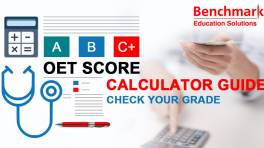

The OET writing subtest is assessed based on the ‘OET Writing Assessment Criteria’.
The OET assessors use the above criteria to evaluate candidates’ ability to communicate effectively in written English within a healthcare setting, assessing their language proficiency and their ability to identify relevant information and organize the content logically.
Table of Contents
Overview of OET Writing Assessment Criteria
The criteria is composed of six components given in the table below:
OET Writing Assessment Criteria
| Writing Criteria | Bands/ Marks | Explanation | Requirements |
|---|---|---|---|
| Purpose | 0-3 | ❖ Immediately apparent purpose ❖ sufficiently expanded purpose |
|
| Content | 0-7 | ❖ Necessary information included ❖ Adding accurate details |
|
| Conciseness & Clarity | 0-7 | ❖ Recognizing irrelevant information ❖ Writing effective summary of patient’s needs ❖ Maintaining clarity |
|
| Genre & Style | 0-7 | ❖ Writing formally ❖ Appropriate register & Tone |
|
| Organization & Layout | 0-7 | ❖ Clear Organization of details ❖ Highlighting key information |
|
| Language | 0-7 | ❖ Grammar ❖ Vocabulary ❖ Punctuation ❖ Spelling |
|
2. ASSESSMENT CRITERIA
The following are the six assessment criteria used in evaluating the writing subtest:
- Purpose
- Content
- Conciseness and Clarity
- Genre and Style
- Organisation and Layout
- Language
2.1 PURPOSE
As the name suggests, purpose is the reason for writing the letter. It should be apparent from the start and developed throughout the course of the letter.
Purpose is conveyed in two parts:
- The first part of the Purpose is to make the reason for the letter immediately apparent to the reader. Consequently, the reader gains a general idea about the possible content as soon as the letter begins. This is conveyed in the introductory paragraph.
- The second part of the Purpose is sufficiently expanding upon the reason for the letter by adding relevant details. It is usually a detailed and specific explanation of the care/action expected from the reader. It is discussed in the last part of the letter (concluding paragraph).
SCORING BANDS FOR ‘PURPOSE’: 0 – 3
- 3 – Purpose is immediately apparent and sufficiently developed as required
- 2 – Purpose is apparent but not sufficiently highlighted/developed (Very common for students to get 2 for a Grade B)
- 1 – Purpose is not immediately apparent & may show very limited expansion
- 0 – Purpose partially obscured/unclear/misunderstood
2.2. CONTENT
This criterion evaluates whether the letter includes all the key information required for the reader to continue caring for the patient. It is also important that this information is accurate and not misinterpreted.
The selection of information from the case notes is solely dependent on the reader. After reading the letter, the reader should have a clear idea about what is expected from them regarding patient care.
SCORING BANDS FOR ‘CONTENT’: 0 – 7
- 7 – Content is appropriate to intended reader and addresses what is needed to continue care (key information is included; no important details missing); content from case notes is accurately represented
- 6 – Performance shares features of bands 5 and 7
- 5 – Content is appropriate to intended reader and mostly addresses what is needed to continue care; content from case notes is generally accurately represented
- 4 – Performance shares features of bands 3 and 5
- 3 – Content is mostly appropriate to intended reader; some key information (about case or to continue care) may be missing; there may be some inaccuracies in content
- 2 – Performance shares features of bands 1 and 3
- 1 – Content does not provide intended reader sufficient information about the case and what is needed to continue care; key information is missing or inaccurate
- 0 – Performance below Band 1
2.3. CONCISENESS AND CLARITY
This criterion evaluates the candidates’ ability to communicate information clearly and concisely. Health professionals value concise and clear communication; therefore, the following can be distracting for the reader.
- Inclusion of irrelevant or unnecessary information from the notes: any information that is outside the scope of the reader’s role and does not have any impact on the care/action anticipated from the reader
- Poor or ineffective summary of the information: wordy/verbose sentences, repeated information, not grouping similar information
SCORING BANDS FOR ‘CONCISENESS & CLARITY’: 0 – 7
- 7 – Length of document is appropriate to case and reader (no irrelevant information included); information is summarised effectively and presented clearly
- 6 – Performance shares features of bands 5 and 7
- 5 – Length of document is mostly appropriate to case and reader; information is mostly summarised effectively and presented clearly
- 4 – Performance shares features of bands 3 and 5
- 3 – Inclusion of some irrelevant information distracts from overall clarity of document; attempt to summarise only partially successful
- 2 – Performance shares features of bands 1 and 3
- 1 – Clarity of document is obscured by the inclusion of many unnecessary details; attempt to summarise not successful
- 0 – Performance below Band 1
2.4. GENRE AND STYLE
The letters written in the healthcare sector are formal, and the writing sub-test reflects this by asking the OET candidates to do the same. This criterion assesses whether the register/style and tone are appropriate for the reader.
In general, candidates may need to adopt a formal style based on the task. Please note, formal writing is polite, respectful, and non-judgemental.
This generally means
- using appropriate salutations
- referring to the patient and others appropriately
- avoiding contracted and short/note forms, informal words/phrases, Latin abbreviations
- being careful about using brackets, abbreviations, medical jargons
NOTE: If the target reader does not belong to medical profession, such as the patient or their next of kin in an OET pharmacy letter, the information must be worded accordingly. For example, minimising medical jargons/technical language
SCORING BANDS FOR ‘GENRE & STYLE’: 0 – 7
- 7 – Writing is clinical/factual and appropriate to genre and reader (discipline and knowledge); technical language, abbreviations and polite language are used appropriately for document and recipient
- 6 – Performance shares features of bands 5 and 7
- 5 – Writing is clinical/factual and appropriate to genre and reader with occasional, minor inappropriacies; technical language, abbreviations and polite language are used appropriately with minor inconsistencies
- 4 – Performance shares features of bands 3 and 5
- 3 – Writing is at times inappropriate to the document or target reader; over-reliance on technical language and abbreviations may distract reader
- 2 – Performance shares features of bands 1 and 3
- 1 – The writing shows inadequate understanding of the genre and target reader; mis- or over-use of technical language and abbreviations
- 0 – Performance below Band 1
2.5. ORGANISATION AND LAYOUT
This criterion assessed whether the OET letter is laid out formally and structured in a way that is easier or harder for the reader to understand.
There is NO set template for an OET letter. However, it is important that the letter has
- all the sections/parts
- the content grouped logically based on theme or timeline so that key information is clearly highlighted
- information sequenced based on relevance/importance in the paragraphs
SCORING BANDS FOR ‘ORGANIZATION & LAYOUT’: 0 – 7
- 7 – Organisation and paragraphing are appropriate, logical and clear; key information is highlighted and sub-sections are well organised; document is well laid out
- 6 – Performance shares features of bands 5 and 7
- 5 – Organisation and paragraphing are generally appropriate, logical and clear; occasional lapses of organisation in sub-sections and/or highlighting of key information; layout is generally good
- 4 – Performance shares features of bands 3 and 5
- 3 – Organisation and paragraphing are not always logical, creating strain for the reader; key information may not be highlighted; layout is mostly appropriate with some lapses
- 2 – Performance shares features of bands 1 and 3
- 1 – Organisation not logical, putting strain on the reader; or heavy reliance on case note structure; key information is not well highlighted and the layout may not be appropriate
- 0 – Performance below Band 1
2.6. LANGUAGE
This is the final criterion and it considers the following aspects of language proficiency: vocabulary, grammar, spelling and punctuations.
This criterion assesses whether the language is appropriate and doesn’t impede the communication.
SCORING BANDS FOR ‘LANGUAGE’: 0 – 7
- 7 – Language features (spelling/punctuation/vocabulary/grammar/sentence structure) are accurate and do not interfere with meaning
- 6 – Performance shares features of bands 5 and 7
- 5 – Minor slips in language generally do not interfere with meaning
- 4 – Performance shares features of bands 3 and 5
- 3 – Inaccuracies in language, in particular in complex structures, cause minor strain for the reader but do not interfere with meaning
- 2 – Performance shares features of bands 1 and 3
- 1 – Inaccuracies in language cause considerable strain for the reader and may interfere with meaning
- 0 – Performance below Band 1
3. SUMMARY
The OET Writing Subtest Assessment Criteria evaluates whether
- the purpose of the letter is immediately apparent to the reader and sufficiently expanded upon througout the letter
- all the necessary information is included and accurate for the reader
- unnecessary information is omitted so that the letter is an effective summary for the reader
- the register, tone and use of abbreviations are appropriate for the reader
- the letter is organised and well laid out for the reader
- the accuracy of the grammar, vocabulary, spelling and punctuation ensures effective communication of the necessary information to the reader
NOTE:
For grade B, predominant score for
- purpose is 2 out of 3
- the remaining criteria is 5 out of 7













I need sample letters
Oet to be learn
If there is differential diagnosis and i mistakenly only gave one diagnosis but saying its suggestive of it how much will i get for purpose?